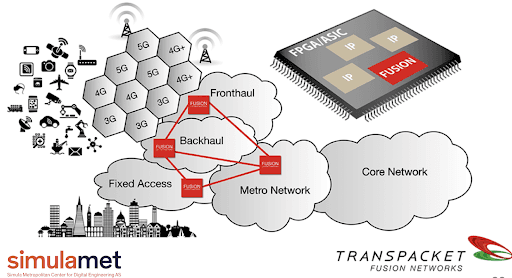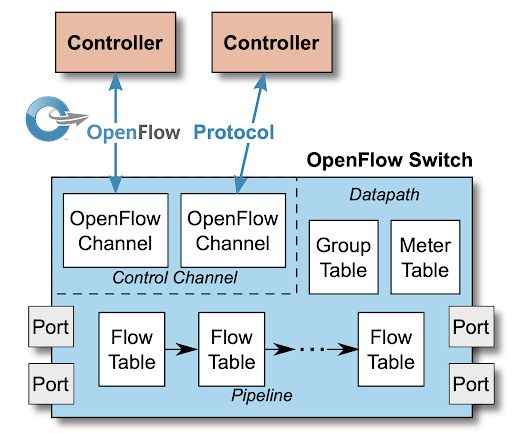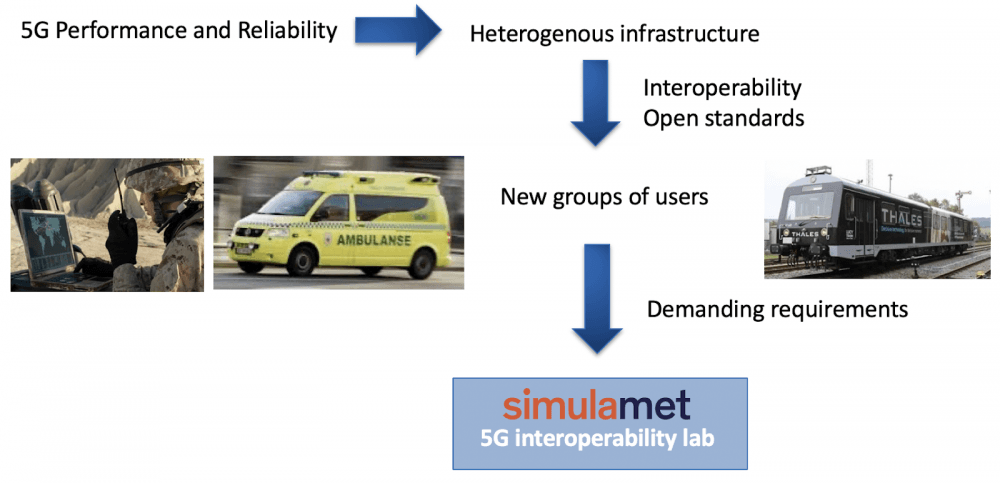SMIL: SimulaMet Interoperability Lab
Research objectives
The SimulaMet Interoperability lab (SMIL) support a wide range of research activities at SimulaMet, and will in particular address the following research areas:
- Benchmark and improve time-sensitive networking technologies for 5G networks between base stations and edge computing for 5G.
- Study and improve mechanisms for network slicing to ensure successful co-use of 5G networks for critical applications.
- Study how legacy computers can be used to realize Cloud Radio Access Networks by using software defined radio and lower cost of deployment by moving functionality from hardware to software. Of particular interest is real-time scheduling of Cloud RAN workloads in edge data centres.
- Study new 5G and IoT applications enabled by edge computing using features such as low latency, high throughput and quality of service guarantees combined with edge computing capabilities available in 5G cellular networks.
- Develop and improve self-driving networks for fast recovery with technologies such as SDN, P4 and Network Function Virtualization in combination with machine learning of large-scale data analytics of the entire networked system.
- Understand and improve mechanisms required to establish Robust cellular networks for reliable infrastructure for new user groups which relies on dependable networks.
Time sensitive networking
Traditionally, dedicated point-to-point connections using Common Public Radio Interface (CPRI) have been used to interconnect smart cellular antennas to base stations. In 5G, the main infrastructure vendors have proposed e-CPRI, based on the Ethernet standard. With Ethernet, one would expect to leverage traditional switches for aggregation and simultaneous data transport in addition to e-CPRI, but Ethernet and legacy switches are not built for the timing requirements of 5G. To overcome this problem, different technologies have been suggested to enable Time Sensitive Networking (TSN) with Ethernet as the transport technology. In this research activity, we study how TSN can be realized in 5G front haul networks, combining the requirements of synchronization, bound latency in combination with traditional best-effort packet transport. In the laboratory we collaborate with TransPacket for access to FPGA-based implementations of TSN using the Fusion network technology implemented in Xilinx FPGAs enabling 100 Gbit/s Ethernet transport aggregating 5G base stations using 10Gbit/s ethernet with guaranteed transport service.

Network slicing
In 5G networks, the concept of Network slicing enables different classes of applications to share the same physical network. 5G is expected to be able to handle applications like emergency networks, real-time industry applications in combination with supporting demanding multimedia applications for consumers. These requirements require ability to express and enforce Quality of Service requirements ranging from frequency resource allocation, 5G base station resource allocation, network quality of service and allocation of processing resources in edge computers.
Initial work has focused on SDN-based implementations using the opensource Open Air interface, and future work will extend this to network slicing in 5G-NR and 5G front-haul and back-haul network guarantees for network slicing.
Cloud Radio Access Networks (Cloud RAN)
Cloud RAN enable the use of general purpose computers placed in edge data centres for realizing virtualized radio functions by using software defined radio techniques to lower cost of deployment by moving functionality from hardware to software. Of a particular interest to our research group is real-time scheduling of Cloud RAN workloads, how to partition between real-time and non-real-time workloads in the Cloud RAN, and how to handle the strict requirements to enable services like Ultra Reliable Low Latency Communication (URLLC) which can enable new applications previously not possible in cellular networks. Vendors are already introducing Cloud RAN solutions, such as the Nokia AirScale CloudRAN , the 4G/5G C-RAN architecture from Ericsson and 5G oriented C-RAN solutions from Huawei. It is of a particular interest to study if such network architectures can be realized in a multi-vendor environment. At what level should interoperability be ensured? Can Virtual Network Functions from different vendors run in the same edge computer environment?
New 5G and IoT applications enabled by edge computing
With edge computing deployed in the distributed 5G networks, new 5G and IoT applications can be made possible since response times can be guaranteed, and computing resources can be made available close to the application. An example is the real-time application of collision avoidance for cars sharing their sensor data with a local edge data center which can execute collision avoidance algorithms within specified time deadlines to provide drivers or self-driving vehicles with time-critical information to avoid collision. Other applications like games using augmented reality and real-time collaboration in industrial applications can be enabled by low latency and high throughput communication service with processing in edge data centres. Finally, IoT sensors with very low power consumption can leverage high sensitivity 5G NR capabilities to provide very long battery life for embedded applications. In SMIL, we will collaborate with other research groups and the 5G industry to investigate applications previously not possible in cellular networks and suggest improvements to applications and networks.
Self-driving Networks
The complexity of configuration and adjustment of telecommunication networks to respond to rapid changes in demand has led to the vision of Self-driving networks which measure, analyze and control themselves in an automated manner. Self-driving networks can react to changes in the environment (e.g., demand), while exploiting existing flexibilities to optimize themselves. Furthermore, the advent of large-scale machine learning can also benefit self-driving networks and over time develop to faster reconfiguration and more reliable operation compared to manual configuration by human operators, see for example the paper Why (and How) Networks Should Run Themselves for an in-depth discussion.
This method is of particular interest in 5G to ensure rapid reconfiguration in case of failure which requires automated response to demand, changes in geographic load in the network, change in network capacity and loss of connectivity with minimal impact for critical applications. The requirement for reconfiguration can also be used for business purposes, for example optimized use of software licenses, where an operator can install hardware at all relevant locations but deploy software licenses only for operation of a subset of this hardware based on actual demand and moved with users. This research area is closely related to Software Defined Networking which until recently has focused mostly on the data plane with technologies such as OpenFlow and Netconf/Yang.

Recent developments such as the Programming Protocol-independent Packet Processors language (P4) has enabled software control also of the data plane which opens for software defined processing in the actual packet flow. In SMIL, we plan to leverage these advances together from SDN controllers such as OpenDaylight to enable Self-driving networks for access and transport networks for 5G. In the laboratory, we will use the latest MX-series routers from Juniper Networks with P4 capabilites to explore self-driving networks for 5G.
Robust cellular networks
New user groups are encouraged to share a common infrastructure to save cost and leverage state of the art technologies. This trend increases the requirements of robustness of the underlying architecture since our society relies not only on critical consumer services like communication services, banking, shopping and logistics, but also applications traditionally served by dedicated networks such as military, emergency (e.g. TETRA) and railroad signalling networks (e.g. GSM-R) which all consider 5G as their network infrastructure in the future.
We believe Heterogeneous infrastructure has several benefits to ensure interoperability and open standards in 5G but this requirement also adds to the complexity of the network since different vendors may rely on different network structures, and different communication protocols even if they are defined by standard bodies such as 3GPP. When the goal of heterogenous infrastructure is added to requirements from new users, we can see that 5G represents very demanding requirements for the cellular operators and the network infrastructure vendors.

SimulaMet Centre for Resilient Networks and Applications have studied this topic over many years in fixed networks, in 4G cellular networks and for IoT applications. With the new laboratory, we will extend our studies to 5G New Radio and will also address how to provide robustness of the 5G core network by reducing the dependency for a centralized 5G infrastructure by virtualization.